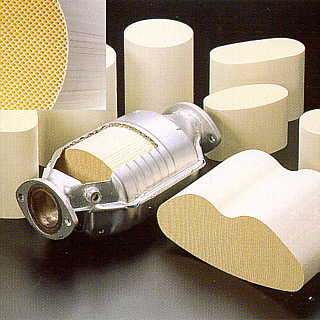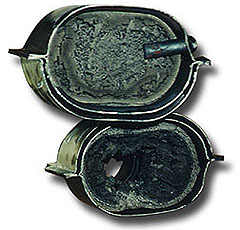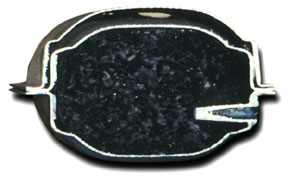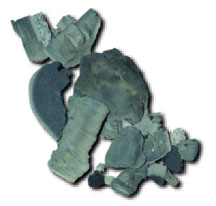|
|
A catyltic converter uses a catalyst to convert three
harmful compounds in car exhaust into harmless compounds.
The compounds are: hydrocarbons (in the form of unburned
gasoline), carbon monoxide (formed by the combustion
of gasoline) and nitrogen oxides (created when the heat
in the engine forces nitrogen in the air to combine
with oxygen).
In a catalytic converter, the catalyst (in the form
of platinum and palladium) is coated onto a ceramic
honeycomb or ceramic beads that are housed in a muffler-like
package attached to the exhaust pipe. The catalyst helps
to convert carbon monoxide into carbon dioxide. It converts
the hydrocarbons into carbon dioxide and water. It also
converts the nitrogen oxides back into nitrogen and
oxygen.
|
|
Reasons for a converter failure
A catalytic converter will rarely fail without a
problem or malfunction occurring somewhere in the emission
system in front of the converter. It is important to
determine what caused the converter to fail, so that
the problem can be fixed and to prevent a recurrence
of the failure. It can be difficult to determine exactly
what caused a catalytic converter to fail, but the following
failure descriptions will help narrow down your search
for the malfunction.
Converter Meltdown:
|
|
|
This is an example of a converter meltdown.
The converter was super-heated due to a raw fuel condition
in the exhaust flow. The excess unburned fuel ignited
when it struck the hot ceramic catalyst and drove the
temperature far above normal operating condition of the
converter. The ceramic catalyst is unable to withstand
the extremely high temperature and begins to melt. The
ceramic collapses and the converter is destroyed. The
melted ceramic may block the exhaust flow and cause additional
damage to the engine. A converter glowing red-hot or evidence
of heat discoloration confirm this situation. |
|
The too-rich condition that led to this converter melt
down could be the result of a number of malfunctions
including faulty oxygen sensor, an incorrect fuel mixture,
worn spark plugs or plug wires, a faulty check valve,
incorrect ignition timing, sticking float, faulty injectors
or other ignition malfunctions.
Carbon Deposits:
|
|
|
This is an example of a converter with carbon
deposits in the ceramic catalyst. This is usually a result
of oil or antifreeze entering the exhaust system or a
too rich fuel mixture. The heavy carbon deposit clogs
the converter and reduces exhaust flow. This increases
backpressure and causes the entire exhaust system to heat
up. The heat backs up into the engine compartment and
may result in a number of heat related engine problems. |
|
Mild ceramic scoring may do less damage to engine components
but it may seriously affect the converter's ability
to reduce harmful emissions. It could easily cause a
vehicle to fail an emission test.
Carbon deposits may be the result of faulty valves,
worn piston rings, worn or leaking gaskets or lead in
the fuel.
Catalyst Fracture:
|
|
|
This is an example of a catalyst fracture.
The ceramic became loose, cracked and began to break down.
The pieces began to obstruct flow, creating backpressure
and increasing the heat in the exhaust system. There is
evidence of partial meltdown in this example due to overheating. |
|
The initial cause for this damage could have been road
debris striking the converter based on evidence of impact
on the converter shell. In some cases, if the protective
mat that holds the catalyst in place is directly exposed
to exhaust gasses; it could deteriorate and allow the
catalyst to fracture. Our protective mat is shielded
from direct exposure by our recessed dual cavity body
and holds the catalyst firmly in place.
If a vehicle caused the OEM
catalytic converter to fail, it could cause the NEW
CONVERTER to fail as well.
|



